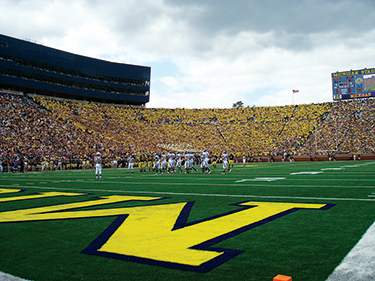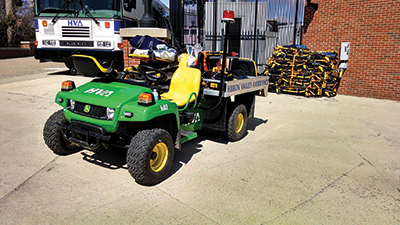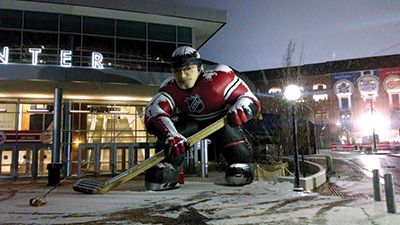
By MICHAEL KENNEDY
In the post-9/11 era, the majority of planning and operations relating to large-venue response has been focused on terrorism or a deliberate criminal act. Ensuring crowd security from a threat such as a vehicle-borne improvised explosive device (VBIED) or a Mumbai-style active shooter attack tends to take the lead for large-venue planning. These types of criminal incidents fall into the low-frequency/high-risk category. The types of incidents that can get overlooked are those many firefighters brush off as “routine” responses-e.g., vehicle fires, medical incidents, and fire alarms. However, there is nothing routine about responding to a vehicle fire in a parking lot outside of a stadium filled with 100,000 people. There is nothing routine about trying to find a patient in cardiac arrest at a golf course that has been converted to an event parking site where the only location description the caller can provide is “a golf course by some large trees.”
One community’s idea of a large venue may have an occupancy of 5,000 whereas another community’s venue may have the capacity of 100,000 (photo 1). In some communities, that Friday night high school football game is just as important to that community as a collegiate football game played on Saturday or a professional football game on Sunday. No matter what the size, the fire department having jurisdiction must ensure it has done the appropriate planning, training, exercising, and outreach to ensure it can respond to its venue with a solid plan, the right equipment, and trained personnel. For the purposes of this article, large-event venues will include stadiums, arenas, amphitheaters, and the like.
 |
| (1) Large-event venues will have a significant impact on fire department operations. (Photos by author.) |
Severe Weather
With the proliferation of personal digital devices, weather data, including radar, are readily available to a wide audience. This accessibility can cause significant issues in terms of evacuation and public safety decision making. Several individuals may look at the same weather data and interpret them differently. The National Collegiate Athletic Association (NCAA) stops play once lightning is six miles away and for 30 minutes following the last lightning strike within that six-mile radius.1 Nothing prohibits a venue from having a wider radius for lightning, and some television broadcast companies have adopted their own guidelines. Ideally, a trained meteorologist should be part of this decision matrix, and some facilities have a meteorologist on site. If this is not feasible, the local office of the National Weather Service is an excellent resource.
Lightning is only one potential aspect of severe weather that needs evaluation. Each venue should have a well-defined decision-making process in place, and the fire department needs to be aware of the process. Depending on the facility, the fire department may or may not be part of this decision process. However, the fire department needs to be aware of the evacuation decision when it is made.
Wayfinding/Response
Some venues control the land around their facility and often use this space for parking. This makes the venue somewhat more of a self-contained entity from an emergency response perspective. These venues are often newer and away from city centers. However, other venues are in more urban/suburban environments. In these latter cases, it is common for adjacent properties to be privately owned and not under the control of the venue organization. This can have a significant impact on wayfinding and response.
One aspect of wayfinding is the descriptors callers use to define their location to 911. Fire officers use wayfinding in a similar manner to direct operations. During typical responses, wayfinding is usually an address or an intersection. However, event organizers may have added advertising signs or promotional material that people may use instead when calling in an emergency. This may make the normal addressing and routing vernacular obsolete. Firefighters need to conduct a pre-event survey the day of the event, so if someone says, “I am by the 30-foot-tall inflatable hockey player,” firefighters know where that is.
Golf courses or open fields around a venue may be used for parking and pre-event tailgating. If someone calls 911 reporting a medical or fire incident and can give no more descriptive details than “on the golf course,” there will undoubtedly be a serious delay in response. The fire department needs to ensure that venue staff and any affected land around the venue have an established wayfinding plan. This official plan will be in addition to informal wayfinding methods 911 callers may use. An official wayfinding plan can assist persons needing assistance by directing them to look at a sign, a flag, colored trash cans, or light post markings to give responders an indication of their location. This wayfinding plan needs to be distributed to all potential responding apparatus.
You must also consider the response package to the area outside of a venue. Having a Class A pumper attempt to drive to a cardiac arrest on a golf course will lead to the predictable result of burying the rig and delaying the response. Having smaller all-terrain vehicles for off-road response or response in tailgate-congested parking lots will allow for a faster, more efficient response (photo 2). Also, you must coordinate with law enforcement so that if a full first-alarm assignment is responding, officers on traffic posts can assist with routing. There may even be a need to move barriers intended to stop a VBIED.
 |
| (2) Smaller, all-terrain vehicles are better suited for response to the areas surrounding a venue than traditional fire apparatus. |
It is common for venues to alter inbound and outbound traffic patterns. Thus, regular alarm assignments may be significantly inhibited when a normal five-lane road has been converted into an outlet only for one-way outbound traffic. A fire department liaison needs to be made aware of the traffic plan, and the fire response needs to be appropriately adapted to account for this. This may include the temporary deployment of apparatus outside of their normal stations to accommodate altered response routes.
Depending on the event and venue, tailgating may be a very large part of the overall game day experience. At Michigan Stadium in Ann Arbor, it is common for guests to show up eight hours before the game to tailgate. Additionally, several thousand people may show up without tickets and tailgate throughout the event. This creates a hazardous stew of alcohol, propane and charcoal grills, and portable generators for flat-screen televisions and sound systems. Fire companies need to conduct pre-event surveys to determine how temporary structures may have impacted occupant egress, apparatus routes, and hydrant access. These routes will require constant monitoring, and there must be an enforcement plan in which the roles of the fire department, law enforcement, and the venue had been previously determined and agreed on. Because of the high likelihood of guests being under the influence, firefighters or venue staff should have a law enforcement escort when enforcing emergency access rules. Even with vigilant enforcement, crowds entering and exiting the venue can quickly block access routes.
A tiered response plan with designated staging areas is recommended. This is another advantage of having smaller all-terrain vehicles. Ideally, these vehicles should have some type of fire suppression capability beyond a 2½-gallon water can. These smaller vehicles hopefully can make a quick response, potentially knocking down a fire and providing routing guidance to larger fire apparatus that have moved into their designated staging areas. In this scenario, having multiple staging areas where a smaller number of apparatus are assigned at each one is better than having one large staging area. This arrangement will allow for a more adaptable response plan.
 |
 |
| (3-4) Fire companies need to conduct pre-event surveys to determine how temporary structures may have impacted occupant egress, apparatus routes, and hydrant access. |
Communications
Coordinating communications is a major issue at any venue. Many venues have started to employ what is known as a radio frequency (RF) coordinator. This person’s primary focus is to record and track the frequencies of the media. With the proliferation of wireless technology, the venue’s home team will want to ensure that any RF device brought into the venue will not interfere with the internal systems. It is critically important that the fire department communicate with this person during the planning process and that this person is made aware of whatever public safety frequencies responding agencies will use.
Doing a communications check when the venue is empty can provide insight into communication dead zones such as tunnels or mechanical rooms, but there is no simulation that can replicate filling that venue with a capacity crowd that brought their smartphones, dozens of media outlets, communications equipment for each team, and the venue support staff such as ushers and food vendors. Because you cannot test the loaded RF environment ahead of time, it is very important that the fire department conduct radio checks for staff assigned to an event. This is a great opportunity to check technological and human systems. Quite often, the communications failure is a firefighter who is on the wrong talk group not having his radio on/turned up or having a dead battery. Also, for those fire departments using digital radios, when was the last time firefighters practiced moving to different zones or profiles on their portable and mobile radios? Do firefighters know what to do if they get a system-busy response?
An overlooked communications aspect is the simple ambient noise a crowd of cheering people can make. A firefighter standing inside a venue with 50,000 people will not hear a portable radio attached to his belt. Portables with speaker microphones that are kept in a traditional turnout coat pocket or worn on a sling-style radio holster will usually not be heard either. The best solution is to provide inner ear microphones to firefighters responding within a venue. Most major radio manufacturers offer inner ear microphone attachments. This investment is well worth it.
Many venues will also experience a cellular network overload when at capacity. A venue of 10,000 people may not experience this problem, but speaking from my experience, a venue with 100,000 people will. Most fire departments employ cellular phones as an essential element of their senior command communications. If this is the case, the fire department command staff needs to make cellular calls before an incident but also during the event to check the system. Although cellular voice calls may not work, texting may still be a viable communications option. Text messages use less of the data network.
Another unique observation is that different cellular carriers may have better coverage during large events. This is usually tied to corporate sponsorships of the event. Additionally, options such as satellite phones and cellular on wheels (COW) are available. COWs, as they are usually referred to, are owned by all of the major cellular companies. They are expensive assets. However, with planning and outreach, a fire department may be able to have one brought in for a specific event. However, it is crucial to ensure that the burden of any costs is clearly articulated and agreed to by the appropriate staff ahead of time.

Ensuring that social media is being monitored for potential emergencies is another key component of a communications plan. Guests may start tweeting about an incident before an official 911 call is made. Even for fire departments with exceptional public information officers, the skills and technology needed to scan social media may be beyond their capability. However, law enforcement fusion centers are outstanding partners when it comes to this function. “Located in states and major urban areas throughout the country, fusion centers are uniquely situated to empower front-line law enforcement, public safety, fire service, emergency response, public health, critical infrastructure protection, and private sector security personnel to understand local implications of national intelligence, thus enabling local officials to better protect their communities. Fusion centers provide interdisciplinary expertise and situational awareness to inform decision-making at all levels of government.”2 Fusion centers have the staff, technology, and experience to assist fire departments in monitoring social media. Additionally, the fusion center staff can provide remote assistance if the staff cannot be located on site.
The United States Department of Homeland Security has a program called “Wireless Priority Service” (WPS), which provides national security/emergency preparedness personnel priority access and prioritized processing in all nationwide and several regional cellular networks, greatly increasing the probability of completing calls. WPS is intended to be used in an emergency or a crisis situation when cellular networks are congested and the probability of completing a normal cellular call is reduced.3 Each enrolled agency will have a WPS coordinator who manages the agency account and authorized users. Each user will be mailed a user card with instructions and authorization code. Coordinating staff with WPS service needs to be done during the planning process.
Special Hazards
There is an expanding trend for venues to host events for which the venues were not originally built. In January 2014, Michigan Stadium hosted a professional outdoor hockey game; in August 2014, it hosted an international exhibition soccer game. These are two examples of owners working to find nontraditional revenue streams for their venues. Just as the fire marshal division must review plans when someone wants to change the occupancy type of a building, these special events can mean significant logistical and operational changes.
Outdoor hockey rinks in a facility built for baseball or football will require a cooling plant that can contain hazardous materials such as ethylene glycol and anhydrous ammonia. There will also be a proliferation of propane tanks to fuel bench warmers for the players and ice resurfacing machines. The use and storage of these propane tanks will require vigilance by the authority having jurisdiction. Thus, a facility that previously had no hazardous materials concerns can suddenly have a host of issues.
Weather poses another issue when an outdoor venue meant for summer use is suddenly used in the middle of the winter. The NCAA recommends that venues terminate or reschedule activities once the temperature is at or below 0°F. (1) Noncollegiate sports may have their own cancellation parameters. If not, fire and emergency medical services (EMS) agencies need to push the venue to develop a winter weather cancellation plan to prevent a mass-casualty incident.
These special events can earn the event organizers and facility owners millions of dollars. This is not to say that the fire department can leverage this to make exorbitant demands for apparatus and staffing. However, in the previously mentioned scenario where there is now a significant hazardous materials element, it would not be unreasonable to require the event organizers to provide funding for having some element of the hazardous materials team on site.
Special events can also bring advertising and merchandising elements that are not usually present. Large inflatable advertising devices could significantly limit egress from the facility (photo 3). It is also important to ensure the basics such as fire lane maintenance and hydrant access (photo 4).
Large-event venues are a huge economic engine for cities and universities, and the teams that play in them can be a source of regional pride; however, these venues can place immense burdens on fire departments. The items mentioned are only some of those that should be in the venue’s emergency operations plan. Fire officials need to be involved in the entire planning process and realize that operations in and around these facilities will require adaptivity and creativity. Whether an emergency response occurs with well-trained, well-equipped, and well-planned resources or is a dysfunctional mess, it will be witnessed live by thousands of people and potentially millions in the viewing audience. Fire service leaders must ensure their staff will be ready for a response that can save thousands of lives and define their department’s reputation for a generation.
Endnotes
1. The National Collegiate Athletic Association. 2013-2014 Sports Medicine Handbook. Indianapolis, Indiana 46206-6222.
2. Homeland Security (2014). State and Major Urban Area Fusion Centers. Retrieved on 29 May 2014 from http://www.dhs.gov/state-and-major-urban-area-fusion-centers.
3. Wireless Priority Service. (2014). About WPSt. Retrieved on 13 April 2014 from https://www.dhs.gov/wireless-priority-service-wps.
MICHAEL KENNEDY is a 20-year veteran of the fire service and chief of the South Lyon (MI) Fire Department. He is a Michigan Fire Fighters Training Council instructor, a Michigan State Police professional emergency manager, and a senior emergency management specialist with the University of Michigan (Ann Arbor). He has a bachelor’s degree in political science from the University of Michigan (Ann Arbor) and a master of public administration degree from Eastern Michigan University.
To request information go to fireeng.hotims.com
Related Links
MODERN MOVIE THEATERS: TRAGEDY IN WAITING?
SO YOU HAVE TO INSPECT… A MOVIE THEATER
Five Women Crushed at Overcrowded Concert in Madrid, Spain
PLASTIC BLEACHERS:A SERIOUS FIRE HAZARD?
Fire Engineering Archives

